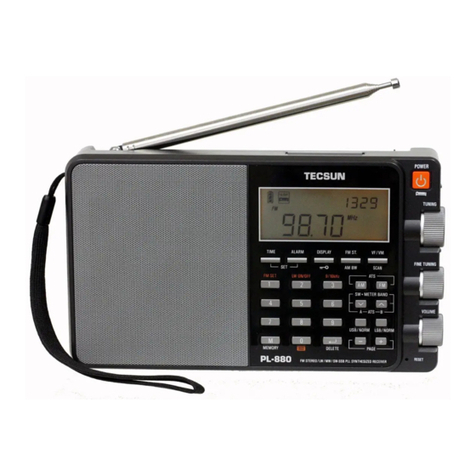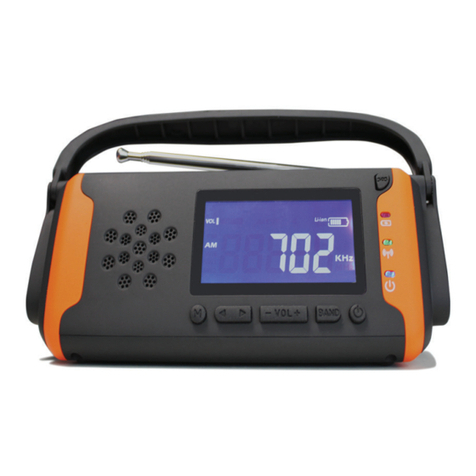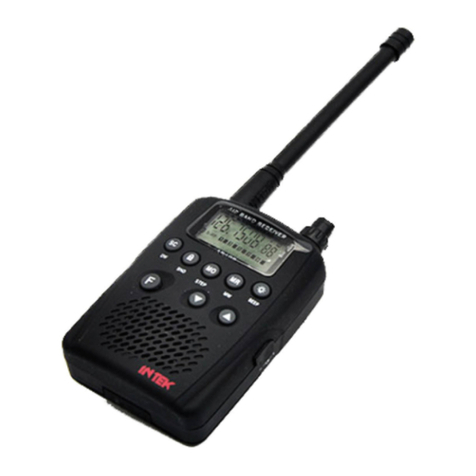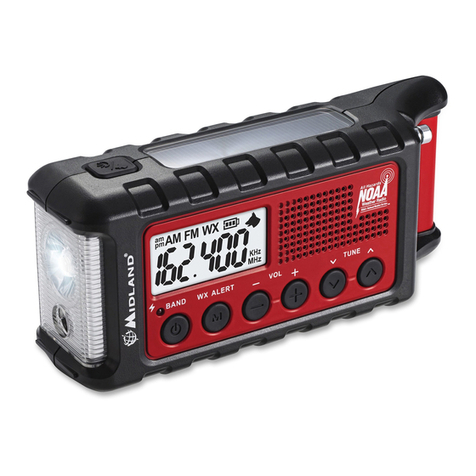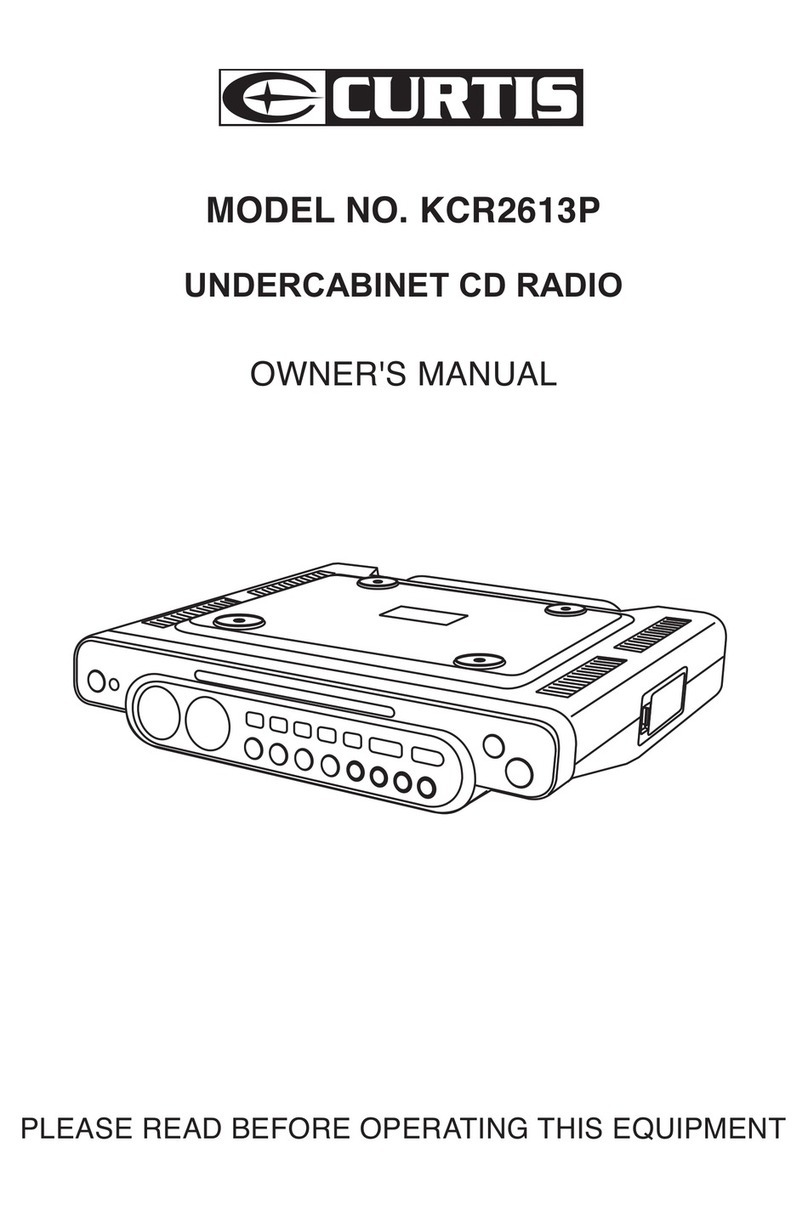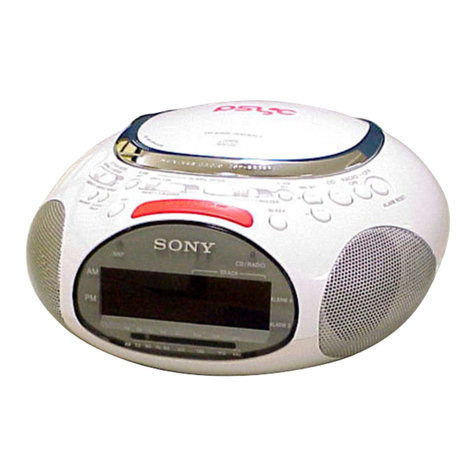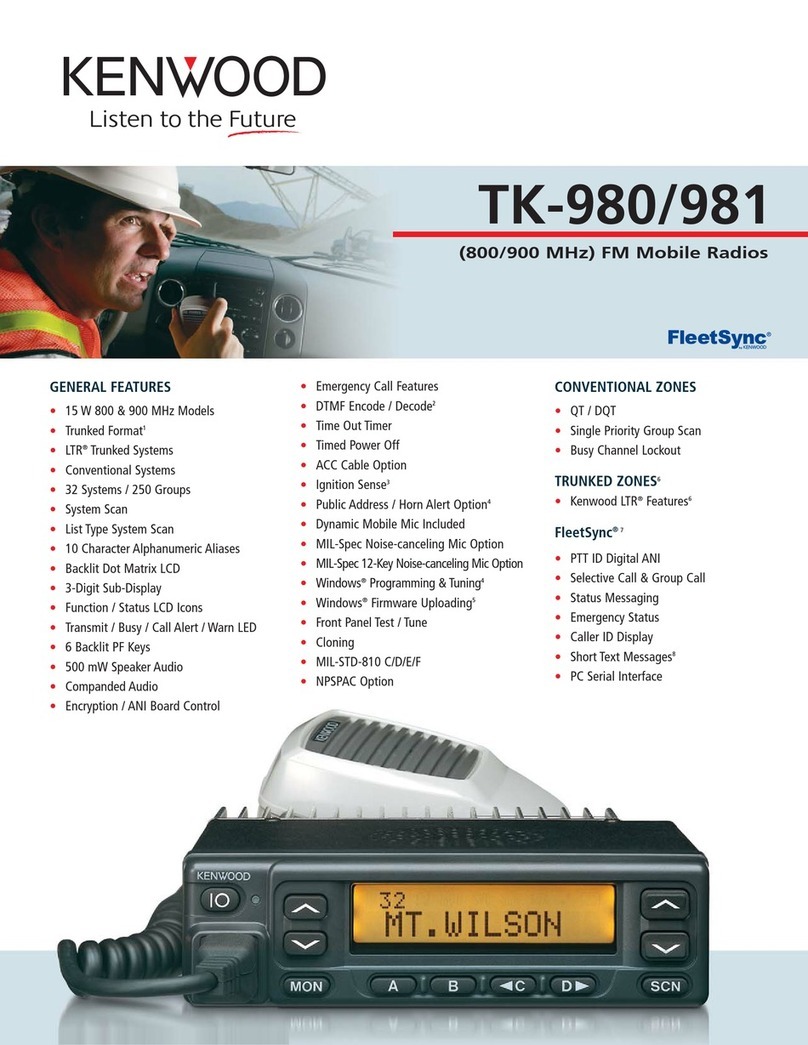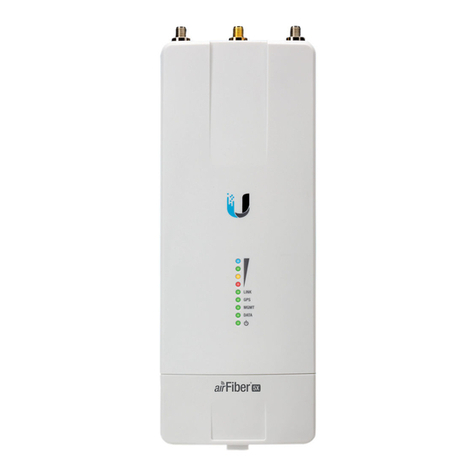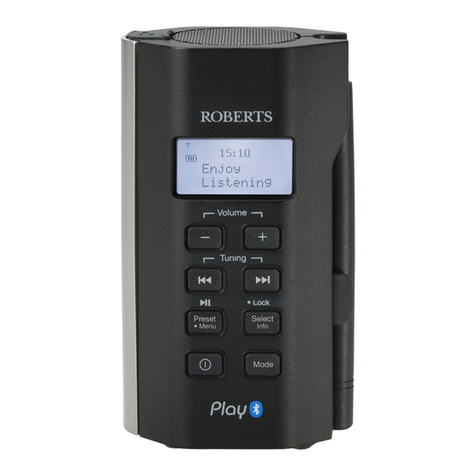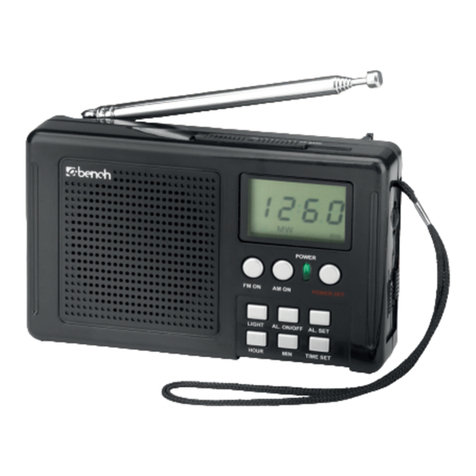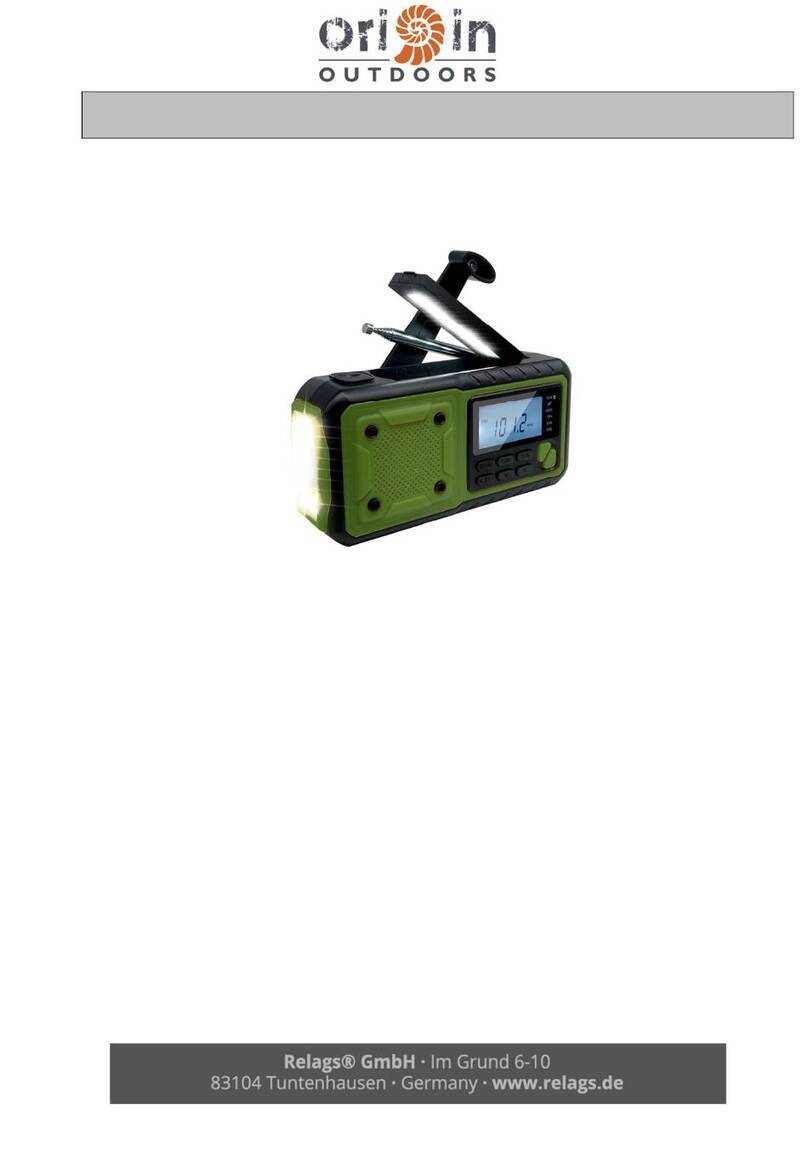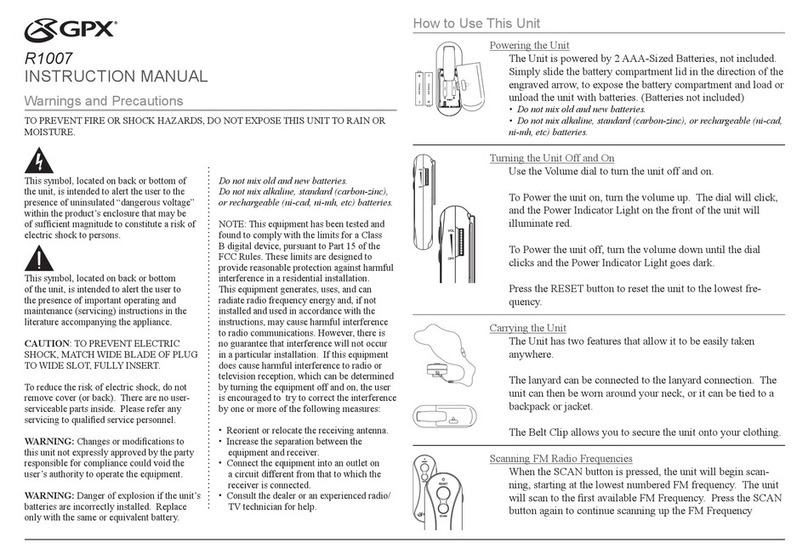Tecsun PL-600 User manual

Review Of The Tecsun PL-600 Radio
-With Comparisons To The Kaito 1103
-And a slant towards medium wave reception
-by Radio-Timetraveller
Purchased rom: www.amazon.com
US Distributer: Kaito Electronics
Price: $79.99 + shipping
Overall Size: 7-3/8" x 4-1/2" x 1-1/4"
Serial #: 20090220
ARRIVAL
My new radio arrived from the Kaito
distributer in California after a one week
UPS trek across country. The PL-600 and
accessories themselves were in a box of
their own inside the shipping box which was
stuffed with Chinese newspapers - I had no
doubt that this Tecsun had come straight out of China! Adequate it seems, as everything arrived in good
shape. Lots of Chinese writing all over the radio box, English as well, this ought to be interesting!
The PL-600 is available in three colors - a medium grey, silver, and black. Kaito sent me a grey one, though
the Amazon ad depicted a black unit. Good enough.
ACCESSORIES
The PL-600 comes with a nice accessory package. Inside was an extremely nice foldover velcro travel case,
external antenna wire wound on a spool (including mini connector and curtain clip), earbuds, 4 NiMH
batteries (1000mAH), a 6 volt wall-wart AC adaptor (for 110V), and manuals.
MANUALS
Yes, manuals. Both English and Chinese manuals were included. The Chinese manual has many graphics
depicting the use of the controls, and even some of the textual balloons are in English, though 99.9% of the
manual is Chinese of course. The English manual is mostly a textual explanation of radio operations with a
few pertinent graphics on pages 3 and 4. The Chinese manual contains a lot of numerical specifications that
are not presented in the English manual.
SETUP
The radio requires 4 AA batteries. Battery level is displayed on the screen, and is accurate for either NiMH
batteries (~1.2 volts) or standard alkalines (~1.5 volts). When you set up the radio, you tell it through a
file:///C:/Documents%20and%20Settings/Administrator/Desktop/tecsun...
1 of 7
8/9/2009 7:53 AM

system set code whether you are using alkalines or NiMH. The NiMH batteries are chargeable right in the
radio using the AC adaptor. You can even set up the charge rate too. Charging automatically shuts off when
finished. Excellent. The radio came preset for NiMH batteries.
The radio was also preset for North
America, in that the medium wave (MW)
broadcast band split was already set up for
10KHz. The long wave band (100KHz -
520KHz) was already activated too (the
LW band on this radio is
activated/deactivated by setting a system
set code).
No other setup was required.
UALITY AND ERGONOMICS
The PL-600 build and fit quality is good,
about the same as the Kaito 1103. The
telescoping whip antenna seems a little
cheaper in quality. My top section was
slightly bent the first time it was pulled out, but easily straightened. It is the same length as the whip on the
1103, though not chromed as much.
Buttons are square on this radio, and give a nice solid click when pressed. Lettering is next to each button
(usually above or below), not on the button itself, so it can't be worn off by repeated pressing of the button.
Good thinking. Keypad is layed out very well. Very intuitive. Ergonomically, this radio is a near masterpiece.
You hardly need the manual to learn how to use it.
A front-firing, round speaker is to the left, nearly 3 inches across. The left side of the radio has an external
antenna jack, a three-position attenuator switch, a two-position tone switch (favoring treble or bass), a
headphone jack, and a power jack for the AC adaptor (6 volts, center pin is negative, by the way).
Three knobs are on the right side of the
radio. They are tuning, volume, and B O
(used for tuning SSB). The B O has a
center detent, a nice feature.
On the back of the radio is a flip stand for
elevating the PL-600 if set on a flat surface.
The PL-600 also comes with a handstrap.
THE LCD DISPLAY
The display is clear and easy to read,
contrast is good (better than other reviews
seem to have indicated). Backlight is yellow
with a faint greenish tint to it. I like it, as it
seems more natural and warm. It is 1000%
more readable than my Eton E1, which was
five times the price. The clock shows all the time, and in 24 hour format, hours and minutes only, no seconds.
file:///C:/Documents%20and%20Settings/Administrator/Desktop/tecsun...
2 of 7
8/9/2009 7:53 AM

Two timers are available which can activate the radio for up to 90 minutes.
The PL-600 also has a nice 5-section signal strength bar, with 5 hash marks per section. I find it reads a little
high, but it is an admirable effort at showing signal strength. It does catch your attention, much more so than
the tiny Kaito 1103 signal strength bar.
THE BFO
The B O covers a little more than 2 KHz either side of the tuned carrier, wider than the Kaito 1103. The
B O at detent was close to but not exactly zeroed on the carrier frequencies of the MW stations I checked
(perhaps ~500Hz off). It is touchy to adjust when attempting to tune an AM station using the ECSS method,
but no touchier than tuning a Sony SR -59! I will call it okay for a small portable - at least it has a real knob
to grip and a wide range.
I find the recovered audio weak when tuning AM stations in the ECSS mode, so I probably won't use this
technique much on this receiver. The B O works well for normal CW or SSB though, and is fun and easy to
tune in stations operating in these modes. It also works well for detecting weak carriers on the MW band.
ANTENNAS
The PL-600 employs a ferrite antenna (4" in length) for the LW and MW band frequencies (up to 1710
KHz). Signal nulling is excellent, and slightly better than my Kaito 1103. It is probably the best signal nulling
radio I own, including the ultralights. Its null is very distinct, where the 1103's seems broader and a fraction
less deep. It's peak also has more of a sharpnesss to it which I don't notice in the 1103. It couples well to a
passive loop, though not as well as the 1103. Coupling distance needs to be closer than the 1103, and the
sweet spot is about two inches down from the top of the radio on the back side.
Shortwave and M employ the telescoping
whip antenna. An external antenna jack is
at the left side of the radio, usable for
shortwave and M, defeating the whip.
ATTENUATOR SWITCH
The attenuator switch (Local, Normal, DX)
works for shortwave and M only. Beware
- the manual errs in stating it works for AM
and shortwave only. It does not work for
AM, unfortunately. While tuning
shortwave, I found the attenuator switch
attenuated signals too heavily even in the
"Normal" position, so I left it in the "DX"
position at all times. It seems to work okay
on the M band.
SENSITIVITY
Sensitivity of the PL-600 is good. On the MW band it is just slightly down from my Kaito 1103 across the
band. Judging by ear on a weak station at noise level, I would figure it to be some 3-6 dB down from the 1103
at worst. or example, a signal barely above the noise level on the PL-600 which is 50% copyable (by voice
file:///C:/Documents%20and%20Settings/Administrator/Desktop/tecsun...
3 of 7
8/9/2009 7:53 AM

intelligibility) will be just at the threshold of 100% copyable on the 1103. Used as your primary receiver, the
slightly less sensitivity of the PL-600 on MW becomes a moot point if combined with a signal enhancing
agent like a Q-Stick or even a small tunable passive loop.
On M, the PL-600 is about the same sensitivity as the 1103. A cursory check was done on several weak
stations, and strength was identical in all cases.
Sensitivity on the shortwave bands is so close I can't tell a difference. A few extra feet of wire clipped to the
whip greatly enhances shortwave signal strength.
TUNING
In tuning the radio, no chuffing or dropout is apparent, and tuning is very smooth. Two tuning speeds are
available, slow and fast, selectable by pressing a button on the front of the radio. In the fast speed, the radio
tunes in 9 or 10 KHz increments on the MW band using the tuning dial or up and down buttons, 5 KHz on the
shortwave bands, and 100 KHz on the M band. ast speed tunes through the LW band in 9 KHz increments.
In the slow speed, the radio tunes in 1 KHz increments on the LW band, MW band and shortwave, and 10
KHz on the M band.
Direct entry tuning couldn't be easier, and is
the best on any radio I have used lately,
including the Eton E1 and my old Drake
SW-8. Simply punch in the frequency and
the radio tunes to it - no pressing an "Enter"
key, or period "." key twice, etc. It does in
fact have an "Enter" key, however it is
generally only needed on the M band for
MHz operations if you choose not to enter
the trailing zeroes. Also, general band
selection can be done by the "carousel"
method. There is a button which takes you
through LW-MW- M, and another button
that carousels you through the shortwave
bands.
SCANNING
Scanning is simple. Simply press and hold the "Up" or "Down" tuning button for a couple of seconds and the
radio will scan in that direction through the current band. The PL-600 has a special function called Automatic
Tuning Scan (ATS), which will scan both the MW and M bands for receivable stations. Those found are
saved in the P0 (Page 0) memory bank. Up to 100 can be saved. Simply press and hold the LW-MW- M
button and the ATS scan starts. A very nice feature.
FILTERS
Two filter widths are available for LW, MW and shortwave - wide and narrow, most likely 6 KHz and 4 KHz.
The English manual does not specify the filter widths, although I am fairly certain the narrow filter is a 4 KHz
one.
I tested both against strong local channels on the MW band. Both radios have front-end overload tendencies
file:///C:/Documents%20and%20Settings/Administrator/Desktop/tecsun...
4 of 7
8/9/2009 7:53 AM

in an extremely strong signal area, and at my location I have one problem station: a 20KW transmitter at 4.9
miles distance. Both radios suffer mild overload and desense with the 20KW station at full daytime (20KW)
power in the wide filter setting, though dramatically less in the narrow filter setting. This is not a defect in
either radio at signals of this magnitude with standard filtering (non-DSP), considering their price point. My
problem station drops its power to 500 watts at night, so further testing was done at that time.
Continuing on after dark, the wide filter feels slightly wider than my Kaito 1103, and a little extra slopover is
heard on the PL-600 at +/-10 KHz either side of a strong station. The PL-600 wide filter setting introduces a
bit of treble hiss into the audio, more than the 1103. This is natural of its own right, regardless of the radio,
though I attribute this on the PL-600 to the audio curve tending much more towards the treble end of the
spectrum than the 1103.
The narrow filter is very close in performance to the 1103's. Adjacent channel slop is minimal on strong
stations and about the same as the 1103. In an additional bonus, I found the narrow filter on the PL-600 to be
lengths ahead in audio intelligibility as opposed to the 1103's. To me, the 1103's narrow filter sounds muffled.
Not so on the PL-600. Signals are crisp and intelligible like tube sets used to be. Old timers will remember this
sound, almost a feeling of being out there in the "ether", a third-dimensional feeling. Which brings us to
audio....
AUDIO
Audio seems to be the sticking point for
most critics of this radio. The complaints I
have read indicate that it sounds harsh or
distorted. It definitely tends towards the
treble end of the spectrum, both with the
wide and narrow filters, which is not to the
taste of many people. I found YouTube to
be a great source when pre-screening a
radio for purchase, as you can not only
SEE, but HEAR it in actual use.
So check out the video reviews on
YouTube. They give you a pretty good idea
of the audio quality. Some will like it and
some will not. I actually like my audio a bit
harsh, skewed to the treble side. I think it aids in intelligibility with identifying DX. Many sets have too much
injected bass, which muddies the signal. I always felt the renowned Sony 2010 was the worst offender here -
great audio in the wide filter position, but total unintelligible mush in the narrow position, like someone
speaking through a pillow. Why have a narrow filter if the audio is so unintelligible it's not usable? Another
tip - use headphones. Audio is always better in headphones.
Lastly, the PL-600 does not incorporate a Line-Out jack, where the Kaito 1103 does. This would have been
helpful.
IMAGES
Both the PL-600 and the Kaito 1103 do have some image problems (what radio in this price range doesn't?). I
found my PL-600 images to be about the same number and strength as my 1103 on each filter setting. A good
way to tell? Tune your radio down in the long wave area between 100 KHz and 520 KHz and look for AM
broadcast band signals 2 times (2X) the I frequency down (910 KHz for the PL-600, and 900 KHz for the
file:///C:/Documents%20and%20Settings/Administrator/Desktop/tecsun...
5 of 7
8/9/2009 7:53 AM

1103). Another good place to check for images is in the 60 meter shortwave broadcast band, 4750 KHz -
5100 KHz. Strong stations in the 49 meter band (5750 KHz - 6200 KHz) will produce images here, at 900 or
910 KHz lower. Both radios show problems in this band as well.
SIGNAL SPURS
In a quick check of the MW band, I found a couple of signal spurs on the PL-600, showing up as weak
heterodynes. One was at 550 KHz, which was probably a weak image combination with another local AM
powerhouse station at 1460 KHz. The Kaito 1103 had a nice image of this station at 560 KHz, with full but
weak audio. No image audio of this station was apparent on the PL-600 at 550 KHz, just the weak
heterodyne, which by the way was nullable, another indication it is image-related.
NOISE IMMUNITY
The PL-600 seems less noise-prone than the
Kaito 1103. In that, I mean it has less
susceptibility in reproducing household R I
noise than the 1103. I can take both radios
to a particular part of the house plagued
with R I from computers, switching
supplies, lighting, etc., and the 1103 is
always markedly noisier. The PL-600's
LCD display is also quite a bit cleaner than
the 1103. Moving your hand close to the
1103's display produces a tremendous
amount of hash. Not so with the PL-600.
MEMORY
The PL-600 has 600 memories, divided into ten pages of 50 each, and one page of 100. Even this can be
modified when you set up the radio. I've never been one much for using memory on radios, preferring to tune.
But memory operation couldn't be simpler, and is very intuitive. Tune the station, press the Memory button,
select the memory slot#, press Memory button again to store a frequency. You can even copy a memory
location into another one, a nice feature. Recall is even easier.
SUMMATION
I find the Tecsun PL-600 to be a marvelous radio for the price, and one I will keep. It is a strong contender
against the Kaito 1103 in performance/price range, stronger than any other I know at this time, and definitely
worth the $79.99 asking price. Realize it is near half the asking price of a Grundig G5 or a Sony SW7600GR,
and 95% as able. Though the audio might be considered a little harsh depending on taste, it is adequately
sensitive, selective, and has great nulling and peaking ability on medium wave. It has terrific ergonomics and
software, 600 memories, and adequate filters - specifically the narrow filter having excellent audio recovery
(particularly apparent in headphones). It has two tuning speeds, a well-designed B O, a main tuning knob
including up and down tuning buttons, a real volume control, a bright (with backlight) easy to read display,
and a well-supplied accessory package. It will make a great substitute for my ailing 1103, and a great spotting
radio for MW band DX.
file:///C:/Documents%20and%20Settings/Administrator/Desktop/tecsun...
6 of 7
8/9/2009 7:53 AM

file:///C:/Documents%20and%20Settings/Administrator/Desktop/tecsun...
7 of 7
8/9/2009 7:53 AM
Other manuals for PL-600
1
Table of contents
Other Tecsun Radio manuals
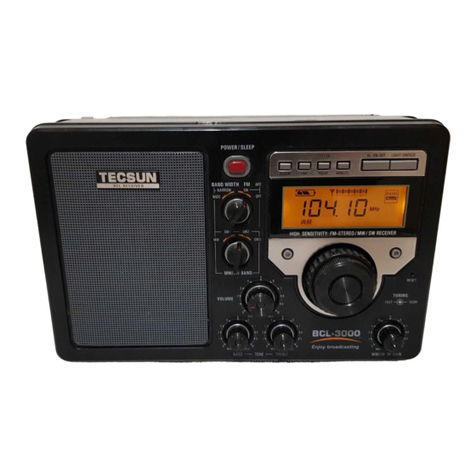
Tecsun
Tecsun BCL-3000 User manual
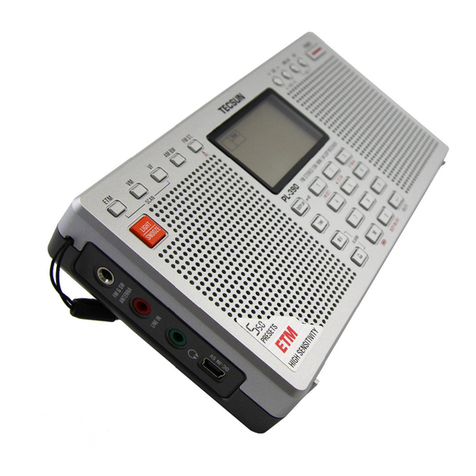
Tecsun
Tecsun PL-390 User manual
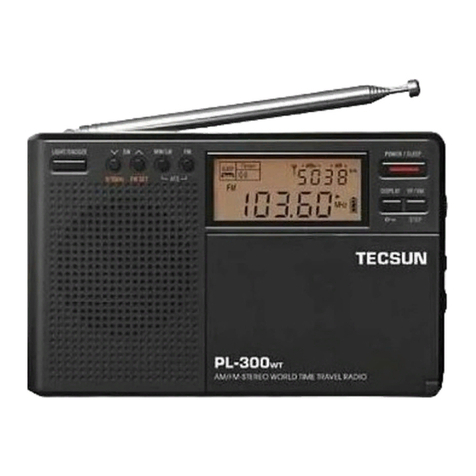
Tecsun
Tecsun PL-300wt User manual
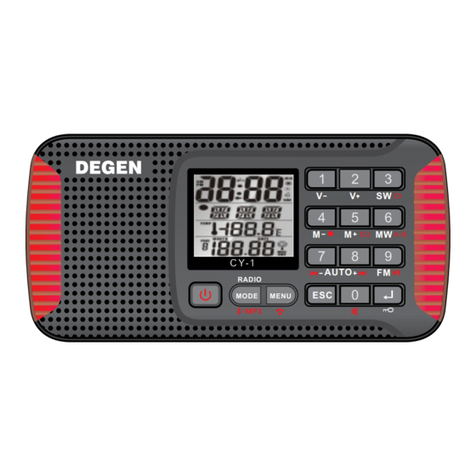
Tecsun
Tecsun DEGEN CY-1 User manual

Tecsun
Tecsun DRM User manual
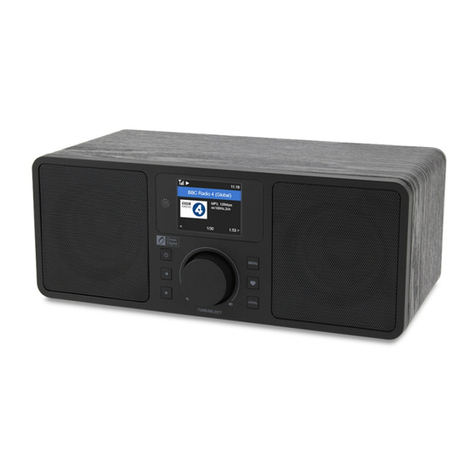
Tecsun
Tecsun WR-230SF User manual
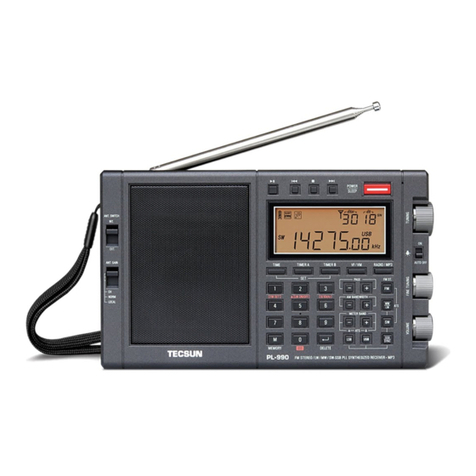
Tecsun
Tecsun PL-990 User manual
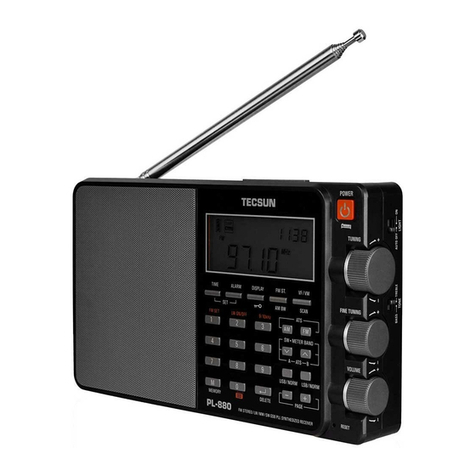
Tecsun
Tecsun PL-880 User manual
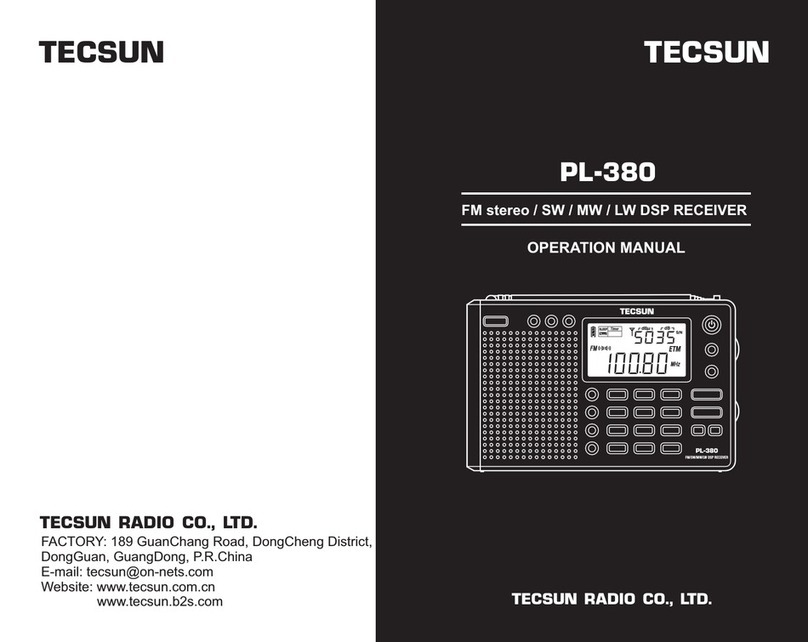
Tecsun
Tecsun PL-380 User manual
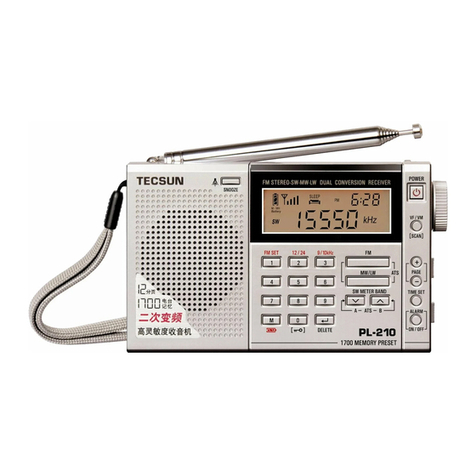
Tecsun
Tecsun PL-210 User manual
